Conroe Buying Guide: Feeding the Monster
by Gary Key & Wesley Fink on July 19, 2006 6:20 AM EST- Posted in
- Motherboards
High-Resolution Gaming Performance
We are using the same game benchmarks in our standard gaming performance section that consists of Serious Sam 2, Half Life 2: Lost Coast, F.E.A.R, Quake 4, and Battlefield 2. All boards were tested with the EVGA 7900GTX using NVIDIA 91.31 WHQL drivers. The Intel 975X boards were also tested with a single ATI X1900XTX card with the Catalyst 6.6 driver. The SLI results on the ASUS P5N32-SLI SE utilized two EVGA 7900GTX cards and the 91.31 drivers with profiles enabled for each game. The CrossFire results on the Intel 975X boards utilized our ATI X1900XTX and X1900 CrossFire Edition cards with the 6.6 Catalyst driver.
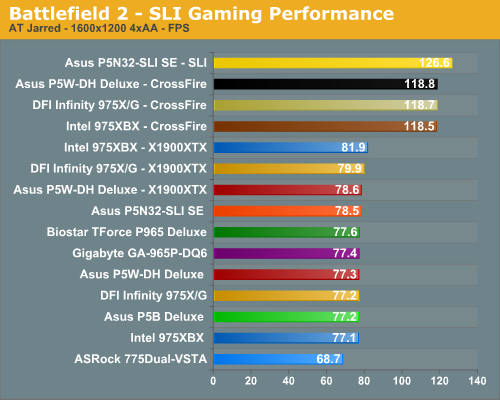
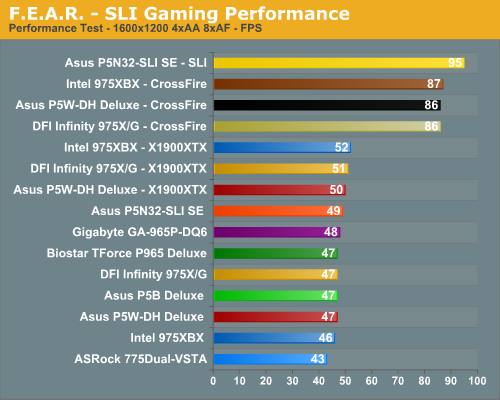
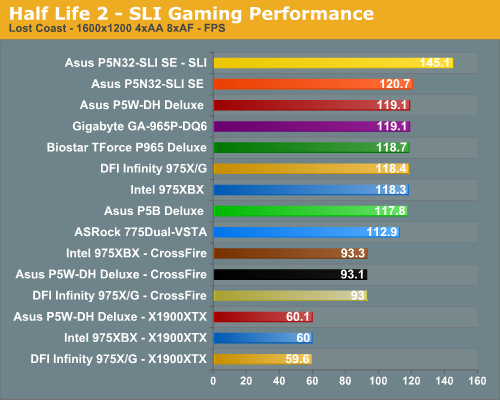
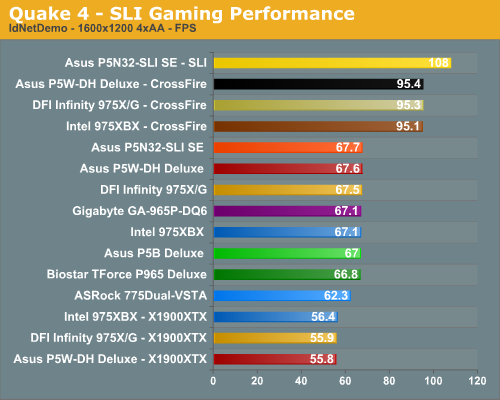
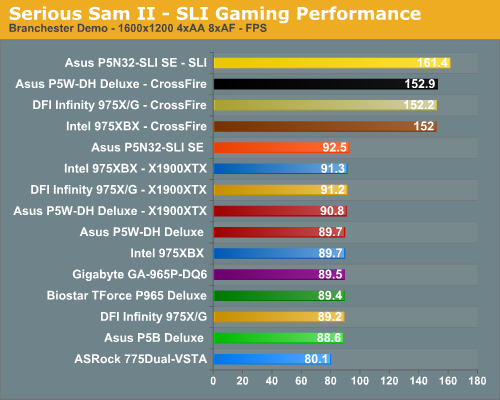
The single card 1600x1200 results with the EVGA 7900GTX card shows the ASUS P5N32-SLI SE taking a clean sweep of the benchmarks. The performance of the 7900GTX and nForce4 Intel Edition chipset made a small but measurable difference at the higher resolutions as the boards started to become GPU bound. Due to the strength of the NVIDIA SLI setup along with obvious ATI issues in the Half Life 2: Lost Coast and Quake 4 benchmarks this same board sweeps our multi-GPU tests.
However, we also noticed where the ATI cards made a very strong showing in our standard benchmarks in F.E.A.R. and Serious Sam 2 by finishing first, they fell behind the SLI setup when running CrossFire indicating a lack of optimizations or possible driver issues in our tests. The performance percentage drop of the ASRock board compared to the other boards when moving to 1600x1200 was even greater than at 1280x1024 indicating that X4 PCIe operation is certainly hampering its performance.
We are using the same game benchmarks in our standard gaming performance section that consists of Serious Sam 2, Half Life 2: Lost Coast, F.E.A.R, Quake 4, and Battlefield 2. All boards were tested with the EVGA 7900GTX using NVIDIA 91.31 WHQL drivers. The Intel 975X boards were also tested with a single ATI X1900XTX card with the Catalyst 6.6 driver. The SLI results on the ASUS P5N32-SLI SE utilized two EVGA 7900GTX cards and the 91.31 drivers with profiles enabled for each game. The CrossFire results on the Intel 975X boards utilized our ATI X1900XTX and X1900 CrossFire Edition cards with the 6.6 Catalyst driver.





The single card 1600x1200 results with the EVGA 7900GTX card shows the ASUS P5N32-SLI SE taking a clean sweep of the benchmarks. The performance of the 7900GTX and nForce4 Intel Edition chipset made a small but measurable difference at the higher resolutions as the boards started to become GPU bound. Due to the strength of the NVIDIA SLI setup along with obvious ATI issues in the Half Life 2: Lost Coast and Quake 4 benchmarks this same board sweeps our multi-GPU tests.
However, we also noticed where the ATI cards made a very strong showing in our standard benchmarks in F.E.A.R. and Serious Sam 2 by finishing first, they fell behind the SLI setup when running CrossFire indicating a lack of optimizations or possible driver issues in our tests. The performance percentage drop of the ASRock board compared to the other boards when moving to 1600x1200 was even greater than at 1280x1024 indicating that X4 PCIe operation is certainly hampering its performance.










123 Comments
View All Comments
Beaner - Wednesday, July 19, 2006 - link
Very well-written article guys!Thanks for taking the time to enlighten us all.
Just wanted to point out that the Mushkin Redline sticks can be had right now for $355 AR. At that price, I may just have to grab 'em myself!
ChronoReverse - Wednesday, July 19, 2006 - link
It was pretty much shown that the effect of using memory dividers for Athlon64's was rather minimal while most dividers were more adverse for Netburst.How large of an effect does using memory dividers have on the Conroe?
Wesley Fink - Wednesday, July 19, 2006 - link
The effect of memory dividers is much smaller on Conroe than we saw on Netburst. In fact memory dividers on Conroe behave more like AM2 - probably the result of the "apparent" reduction in latency with the intelligent look-ahead in memory. Core 2 Duo is not Hyper-Transport, so 1:1 (533) tis still theoretically the highest performing setting, but we were hard pressed to find any measurable advantage of 1:1 in most situations.We had tested a number of high-performance dimms on Conroe before we wrote the Buyers Guide, but there just wasn't the time - or room - to include full memory performance data in the Guide. We do have memory reviews in process that will provide specifics to your questions.
We can summarize what we have learned about memory on Conroe so far. DDR2-667 is quite a bit higher in real perfomance than DDR2-400 or DDR2-533 (1:1). We would consider DDR2 to be the minimum memory that should be used with Conroe. Going up from DDR2-667 we found the following - from fastest to DDR2-667. DDR2-1067 4-4-4 is a bit faster than DDR2-800 3-3-3 is a bit faster than DDR2-667 3-2-3. Timings are very important above DDR2-667 and you can give up any performance advantage with slower timings. DDR2-667 is a good match to COnroe bandwidth, and is better perfoming than 533 or 400 by a wider marging than you find above DDR2-667. It also appears Conroe responds better (performs better with increases) to DDR2 bandwidth increases than either Netburst or AM2.
Wesley Fink - Wednesday, July 19, 2006 - link
We would consider DDR2-667 the minimum memory to use with Conroe, and faster timings do generally improve performance.Sunrise089 - Wednesday, July 19, 2006 - link
I would like to know this as well.txt2000 - Wednesday, July 19, 2006 - link
Just wondering, if your going to spend ~$400 on memory if you would be better off with 4GB value DDR or 2GB high performance.Patsoe - Wednesday, July 19, 2006 - link
I suppose that completely depends on your usage pattern. Almost all of my activities fit within 512MB, and probably anything I do fits within 768MB. So getting faster RAM would do more for me than more of it.If you could fill 3GB, then a setup with 2GB will see a lot hard-disk swapping... even a very slow 4GB of RAM will do better in that case.
Andy4504 - Wednesday, July 19, 2006 - link
Anything over 1GB results in the OS addressing your memory differently. Never did the reasearch on how that different addressing affected system performance however.supremelaw - Wednesday, July 19, 2006 - link
http://www.anandtech.com/mb/showdoc.aspx?i=2797&am...">http://www.anandtech.com/mb/showdoc.aspx?i=2797&am...Timing and content were perfect for this article.
And, your earlier article on the nVidia 590 chipset
for Intel also dovetails perfectly: nice photos too.
August+ should be VERY interesting.
Many thanks!
Sincerely yours,
/s/ Paul Andrew Mitchell
Webmaster, Supreme Law Library
http://www.supremelaw.org/">http://www.supremelaw.org/
mobutu - Wednesday, July 19, 2006 - link
"The board was very stable with our X6800 and X6600 Core 2 Duo processors ..."It should have been E6700 (or maybe E6700)